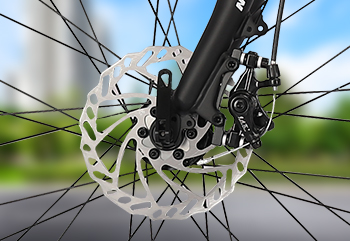Explained: The Science Behind Cycle Brakes

A cycle is not one unit; instead, a collection of different components that come together to give us a seamless experience of riding on different terrains. There are various parts on a cycle like a suspension fork, handlebar, gears, tires, sprockets, and so much more. One such part happens to cycle brakes. Brakes are some of the most important components in a bike, there are various brakes available, and one must have a good understanding of these bikes before purchasing a cycle for themselves. Knowing about brakes enables us to understand them better and even adequately care for them. Let's go over the different bicycle brakes.
Bikes, in a broad sense, can be of two types. They can be mountain bikes or road bikes. There are, of course, different types of cycles, such as all-terrain or hybrid bikes; however, these bikes too lean either towards the road or mountain bikes in their features. The brakes on road bikes and mountain bikes are different, and this is due to the difference in the terrain. An MTB like the Direwolf 29T by Ninety One Cycles will have fast and dynamic bicycle disk brakes; these are useful on declines and powerful. However, a road bike like the Tracer 700C will have caliper brakes; these brakes are suited to roads and enhance the riding experience on a paved surface.

However, before we jump over to the types of brakes, let's understand brakes. Brakes are an essential part of the bicycle that helps us regulate the speed were traveling; while riding, if we use the brakes, we can decrease the bicycle's speed or even get it to a complete stop. Brakes are essential for the safety of the cycles, and sometimes it's required to adjust our speed as per our surroundings. A rider must never compromise on the quality of the cycle brakes. Brakes use friction on the surface to maneuver the speed.
Different types of brakes:
Disc brakes:
Disc brakes are one of the most powerful brakes available in the world of cycling. These brakes give the most consistent performance in all weather conditions; they will give you supreme response even on treacherous and technical terrains. This makes disc brakes highly compatible with bikes meant for off-roading, mountain bikes, all-terrain bikes, and bicycles meant for extreme adventures and races that often have disc brakes. However, these brakes are also suitable for hybrid and commuter brakes. Disc brake cycles are more efficient than others; they have long-lasting brake pads and are powerful. However, these brakes are expensive and might reduce aerodynamic performance. Some components of a disc brake include a disc brake rotor, a disc brake pad, and a disc brake caliper. There are two main types of disc brakes: mechanical and hydraulic.
Rim brakes:
Some of the oldest types of brakes, the rim brakes have reduced in popularity after the introduction of disc brakes. These brakes are lightweight and prevalent in road cycles as they make the bike even more aerodynamic. Rim brakes are attached to the wheel, and when applied, they create friction on the rim's surface. Increased friction slows or stops the bike completely. Like bicycle disc brakes, there are a few types of rim brakes as well: caliper rim brakes, V brakes, and cantilever rim brakes. Rim brakes are cheaper and simple to maintain. It's also easy to find a replacement for them. However, they are unsuitable when posed with adverse conditions and don't perform well for an extended period.

Bicycle drum brakes:
These types of brakes were introduced in 1902 and were a popular choice for automobiles. These cycle brakes are highly uncommon these days. This brake is a type of hub brake and sits at the center of the wheel. When applied, this brake applied friction to the outer drum and reduced the bicycle's speed. These brakes perform well in mud and snow and apply perfectly in wet conditions. These bicycle brakes are, however, heavier and not very powerful.
Coaster brakes:
These brakes are different from the four above. The rider has to pedal backward to stop the bike. These brakes are suited to bikes where leisure riding is the purpose. These brakes also don't require cables. However, there are many pros and cons to this type of bike. These brakes are narrow, simple to use, and put less strain on the bike wheel. However, the brakes are less powerful and overheat quickly. It's also easy to skid using this brake, and there's a learning curve to it as well.
The brake type depends upon the bicycle category and the cyclist's riding style. One must do their research before arriving at a decision.
Some maintenance tips:
- Rim brakes should be checked regularly, especially before an intensive ride.
- Brake pads are essential for bicycle functioning; therefore, they should always be in premium condition.
- If your brake pads have groves and are misaligned, they should be fixed.
- Brake pads should always be cleaned; if there is any debris, stone, grease, or grime, then it should be gently cleaned.
- Disc brake cycles are technical when it comes to cleaning and maintenance. Always go to an expert for it unless you're the expert.

Just like the whole bike needs cleaning, so do brakes. They are some of the most important specifications of a bike. Different brakes need different types of cleaning. However, choosing from disc brakes or v-brakes are matter of discussion now due to it's specifications. Most road bikes prefer rim brakes as they are lightweight, and cyclists are concerned with speed and aerodynamics. However, when it comes to mountain bikes, disc brakes are preferred. The rugged terrains are moody and might throw any obstacle in the cyclist's way. Therefore, powerful disc brakes are preferred. This is a general statement, and many cyclists might prefer something else. A rider needs to understand their personal style and use that as a ballpark for selecting a cycle.
- Brakes
- components
- Science
Related Blogs

Cycling Tips
Conquer the Ride: Essential Bicycle Repair Tips for Every CyclistLearn how to fix common bicycle problems easily! From flat tires to loose chains, this guide helps you keep your ride smooth. Perform quick safety checks before every ride for a worry-free cycling experience. Gain confidence as a cyclist with basic repair skills!

Bicycle Know-Hows
Understanding The Most Essential Component Of A Cycle: Disc BrakesRead this extensive guide on all things disc brakes! From the definition to the working, find all your questions answered.
